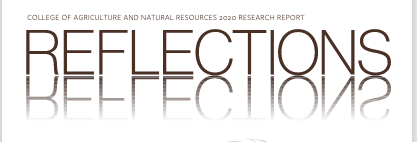
Using fruit flies to understand the molecular basis of human disease and examining the early calf microbiome to improve feed efficiency in cattle are among stories highlighted in the research magazine Reflections from the University of Wyoming.
The magazine is available online at bit.ly/uw-reflections2020 and highlights research in the seven departments of the College of Agriculture and Natural Resources. The magazine is published by the Wyoming Agricultural Experiment Station.
Fruit flies and humans share similarities at the molecular level, said Todd Schoborg, who uses the biological similarity to learn how genes, cellular machines and cells work in fruit flies to understand how they work in humans.
“A fly’s eye develops in much the same way our own eyes do, using the same set of genetic instructions, cellular machines, and cell types to make a highly complex organ,” said Schoborg, as assistant professor in the Department of Molecular biology. “In fact, the fly eye develops just fine using either its own eye gene or one from a mouse!”
He added that the fruit fly also serves as an excellent model for understanding cancer. Schoborg’s article received the magazine’s first-place award for faculty.
Hannah Cunningham-Hollinger’s research efforts target improving feed efficiency by programming the rumen microbiome in cattle.
“We aim to better understand how the rumen microbiome changes as the offspring develops, how maternal factors influence the early colonization of the rumen and if any early interventions can affect host efficiency in maturity,” said Cunningham-Hollinger, an assistant professor in the Department of Animal Science.
Other departments and research articles are:
Agricultural and applied economics – Efforts to grow niche industries and boost Wyoming’s rural economies through first-grains
Ecosystem science and management – Examining stakeholder-driven studies in the Thunder Basin of northeast Wyoming
Family and consumer sciences – Teaching young adults healthy habits for happy relationships
Plant sciences – Sunn hemp studies as a forage alternative to alfalfa
Veterinary sciences – Efforts to develop improved brucellosis vaccines
The magazine also features two student research projects. One examines the many facets of the prairie dog in the Thunder Basin and another looks at the possibility of growing specialty cut flowers for profit.





